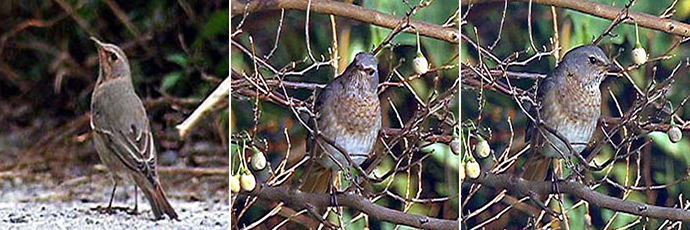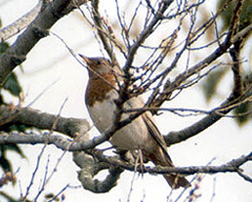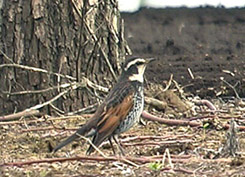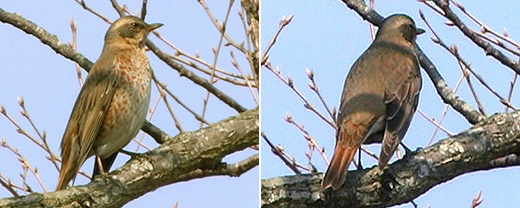Naumann’s Thrush Turdus naumanni naumanni
On October 8th, 2002, while Nial Moores was assisting a wildlife TV documentary team (Wildnet (http://www.wildnet.co.kr) ) on Gageo Island in the far southwest of the country, a reddish-tailed, blue-grey-backed thrush was accidentally flushed from low berry bushes next to the "road’ into deeper cover. From inside the canopy, the bird turned round briefly, revealing a mottled pale throat above a strikingly obvious red gorget contrasting with apparently silky white underparts. It then flew deep into the forest. Even on such very brief views identification was immediate (and over-confident): a "Red-throated" Dark-throated Thrush Turdus ruficollis ruficollis, presumably a first winter male judging by the depth and extent of colour. No Dusky Thrush Turdus naumanni, not even the reddest of naumanni adults, should show such grey tones to the upperparts and such a clear contrast on the underparts. Leaving the TV crew to record better images of this rare vagrant to Korea, NM carried on to the headland, to count raptors, and look for other migrants.
After 30-45 minutes of waiting at the same spot, the Wildnet team successfully relocated the bird, and filmed it while it fed on berries, before it dropped onto the road, and hopped out of view. The bird remained in the same area, though extremely elusive (being seen only once in flight), until at least October 10th.

Going up to Seoul in November to help with editing the program (for broadcast perhaps in late November) we came up to the "Red-throated Thrush sequence". The first views were of the bird head-on. Most striking was the gorget, though somewhat mottled, contrasting as noted with a clean white central belly, but also a largely white throat (suggested by Clements and Hathaway, 2000, as being a feature more typical of females than males). Oddly though, the reddish tones also appeared to continue very strongly down the flanks…as the sequence continued, the bird then dropped onto the road, giving good views of its plain grey upperparts, before it turned…turned both side-on and into what now appeared to be an adult Naumann’s !
As we re-ran the film over and over it became increasingly obvious that this puzzling thrush seemed to be showing features suggestive of both Naumann’s and Red-throated Thrush, raising various questions, most urgent being, how should this bird be labelled in Wildnet’s documentary (the reason for the haste of this article and the especial need for response from experienced observers)?

(same bird as in Fig. 1).
Of perhaps much greater interest to birders both within and outside of the region though - how easy really are these thrushes to separate (there was a mailing by Koji Tagi for example on listservers early in 2002 about a controversial nominate male ruficollis or nominate naumanni in Osaka, Japan)? What are the really diagnostic features to look for? Considering that Clement and Hathaway (2000) suggests that hybrid ruficollis and naumanni have indeed been reported, could this Gageo Island bird actually be a hybrid? And if so, how common might such hybrids be and where might they occur? The last question perhaps has some extra significance for those wishing to see all four forms (Red-throated, Black-throated, Dusky and Naumann’s) divided into separate species - even more so as Portenko (Portenko, 1981, in Clements and Hathaway, 2000) suggested lumping all four together!
Wintering significantly to the west and southwest of Korea, the Dark-throated Thrush is considered to be a vagrant to the peninsula (Lee, Koo & Park, 2000), with fewer than 5 records pre-2001. However, at least one of these records apparently concerned a flock of 5 birds in inland forest, made up of both Red-throated T.r.ruficollis and Black-throated Thrushes T.r.atrogularis (PARK J Y pers. com), suggesting that the species may occasionally occur in rather larger numbers than records suggested.
In the winter of 2001/2002 this suspicion was somewhat confirmed by an unprecedented series of records involving ca 20 individuals, with the first (adult males, one of each subspecies) found on Gageo island on October 17th by Dr. PARK Jin-Young, followed by small mixed groups of both subspecies at e.g. Ganghwa island and Seosan.

The last of these records were in April when an adult male Red-throated was present (and singing) on Eocheong Island (at least between April 19th and 22nd) , followed by an adult male Black-throated in with Dusky Thrushes on April 23rd 2002. These have, incidentally, been followed in October 2002 with at least one (presumed first winter male) Red-throated and one first winter female Black-throated Thrush also on Eocheong Island (see our October 2002 bird news).
Identification of most of these individuals was fairly straightforward. As noted in Svensson and Grant’s highly respected and widely-used "Collins Bird Guide" (1999), Dark-throated Thrush is "Fieldfare-shaped" ( Turdus pilaris), showing in most plumages a distinct contrast between dark on the throat and breast and relatively unmarked belly/undertail coverts, with plain brownish-grey upperparts, and a grey-brown or rusty-red tail dependent upon subspecies. Reference to the plates in the same guide reveal a distinctive species, not at all easy to confuse with Korea’s commonest wintering thrush, the Dusky Thrush, which is described as "shape of Song Thrush" Turdus philomelos and is depicted (subspecies naumanni) with brown upperparts (with pale-marked scapulars), showing no obvious breast band, and extensive red white-fringed "diamonds" on the flanks.
However, as noted rather more accurately in Svensson (1992), some individuals, perhaps most especially poorly-marked first year females of Turdus n. naumanni and Turdus r. ruficollis, can actually appear remarkably similar, when identification according to the same author should be based largely on the presence or absence of marks on the undertail coverts (always whitish, or buffish, in ruficollis, and marked innaumanni).
Unlike the Dark-throated Thrush, the Dusky Thrush is an occasionally very numerous species in South Korea, occurring as both a winter visitor (typically arriving in early to mid-October: e.g. first personal records on Gageo island on 11th October 2001 and 6th October 2002) and perhaps even more commonly as a migrant in spring, especially in March and April. Both subspecies, with numerous individuals showing characteristics of both taxa, are widespread, though with eunomus overall more numerous, and tending to occur more abundantly in the south and east, while nominate naumanni occurs in the highest concentrations in the northwest.

Although eunomus occupies both forest and open country, being especially numerous in rice-fields locally in Korea and typically in Japan (see image left, from Narita, Japan in April), naumanni (particularly singles and small "pure" groups) tends to prefer forest and forest edge, often closely associated with wet areas, such as streams and waterlogged allotments. However, as mixed flocks are typical, overlap is extensive.

Measurements suggest that Dusky Thrush is very similar in overall size to Dark-throated Thrush, though the latter averages both longer-billed and longer-winged (Clement and Hathaway 2000). Thus all the forms are rather heavy-looking and similar in structure (closer to Blackbird Turdus merula or American Robin Turdus migratorius than Song Thrush), with perhaps only head shape often appearing very subtly different: rather flatter-crowned in Dusky than Dark-throated, which in turn tends to have a rounder, thicker, fuller crown. Most plumages are as distinctive as they are attractive, but many individuals, especially worn (?) first winters, can appear much plainer, with worn brownish (even occasionally brownish-grey though perhaps never grey) upperparts, often showing some trace of darker streaks and some reddish-brown tones, especially on the rump/uppertail coverts, and either the scapulars (naumanni ) or on the flight feathers of the closed wing (eunomus). Many poorly-marked individuals also still seem to show a weak malar triangle, and fairly faint markings on the underparts, weakly on the breast sides and typically along the flanks. These dark markings invariably show some paler surrounds (whitish, white-grey or pale rufous) and tend to be more diamond shaped than streaky, as suggested for Dark-throated Thrush. Although often heavily marked (as suggested by Svennson 1992 and Svennson and Grant 1999), at least in the field, the undertail coverts can look white or whitish in some individuals of both subspecies (e.g. plate 3, p. 192, of Iozawa, Yamagata & Yoshino 2000): thus very similar to some Dark-throated Thrush. Perhaps unsurprisingly, several of the calls also appear rather similar too, though the familiar sharp and clacking "Kyeik hyek" calls of Dusky Thrush in direct comparison sounded somewhat higher-pitched in two nominate ruficollis heard in Korea (closer to "yeelk Yeelk") in 2002.
But what of the Gageo Island bird shown in the Wildnet video grabs? Looking in more detail at the images it seems to show several features of a first winter male nominate Dark-throated Thrush:
Clean blue-grey mantle/crown, lacking any obvious dark tips or reddish markings on the scapulars;
Concolorous blue-grey rump (usually more mottled red-brown in bright naumanni);
Short whitish supercilium (usually rather longer in Dusky Thrush, often extending to the rear of the ear coverts; in most very bright naumanni, this supercilium is at least tinged orangey, or can be concolorous with the deepest red-orange of the underparts);
Blackish loral patch (usually rather more diffuse or browner in naumanni);
Clean lower edge to the dried-blood red gorget, contrasting sharply with unmarked white central belly;
Grey admixed into the reddish-brown flank feathers. Such grey has never been noted on any naumanni or eunomus seen by NM (many thousands in total since first in 1990). Can they very rarely show such tones?
However, apparently unlike nominate ruficollis, this individual shows:
very heavy reddish-brown markings along the flanks;
clear orangey-red streaks on the undertail coverts (presumably too extensive for ruficollis, though well within the range for naumanni).
As some apparently pure Dark-throated Thrush can show weak markings on the undertail coverts (e.g. the singing adult male Red-throated Thrush on Eocheong in April 2002), and some Dusky Thrushes show apparently white undertail coverts, is this patterning really as clear-cut and diagnostic as suggested by Svensson (1992)?
If it is, then this bird must surely be a hybrid…
Failing to find images of hybrids or similar birds after an internet search, we have posted this article in the hope of receiving any input from experienced observers; to hear further information on identification criteria (especially of extreme individuals) and also of suspected hybridization between the taxa. As always all input will be acknowledged, both on the site and if possible, in the documentary itself.
With many thanks in advance.
November 19, 2002.


February (a second bird).

T N. naumanni (Probable 1st winter male). February (a third bird).
References:
- Clement P., and R. Hathaway (2000). Thrushes.Helm.
- Iozawa, H., Yamagata N., & Y. Toshiyuki (2000). Nihon no tori: 550. San Ya no Tori. Photographic guide in Japanese.
- Lee W-S., Koo T-H. & J-Y. Park. (2000). A Field Guide To The Birds of Korea. LG Evergreen Foundation.
- Svensson, L. (1992) Identification Guide To European Passerines. 4th ed. Stockholm.
- Svennson, L. and P. Grant (1999).Collins Bird Guide. Harpercollins.
Comments:
Igor Fefelov: I would like to say it is most similar to a female Turdus naumanni naumanni. At the same time, a hybrid is not excluded. I’m afraid a definite conclusion about this bird cannot be reached as it was not caught and not looked at in detail. Generally among thrushes of this group (naumanni/eunomus/ruficollis/atrogularis), which can all be seen in our region around Lake Baikal in non-breeding time, the situation is very difficult and sometimes individuals occur which cannot definitely be [identified on field marks] - even after their collecting.
I think that the problems of possible hybridization and of taxonomic status requires DNA-study as phenotypical expressions are very variable (but in any case a resolution to their taxonomic position will be dependant on the taxonomic concepts which predominate at the PRESENT moment, rather than on real interrelations between the forms).
Igor Fefelov
Research Institute of Biology at Irkutsk State University
PO Box 24, 664003, Irkutsk, RussiaRené Dekker: I have just checked our collection which has a specimen listed as T. naumanni naumanni from Wladiwostock which looks a bit like your bird: it has a pale eyebrow, reddish flanks but also a red throat: the center lower belly is whitish. The specimens of ruficollis never show a pale eyebrow or reddish flanks. HOWEVER, now the question is whether our specimen from Wladiwostock is correctly identified? Maybe it is not T. n. naumanni but a hybrid. So, this does not solve the problem and I see now way how to solve it.
I must confess that your identification seems thorough and that your bird shows characters of both species.What can be said is that it definitely has naumanni genes, but the question is whether it has also ruficollis genes or are there naumanni specimens which look like your and my bird? My conclusion: I am not sure that it is a hybrid.
René Dekker
Curator of Birds
National Museum of Natural History
P.O. Box 9517
2300 RA Leiden
The NetherlandsMartin Garner has kindly made the following observation: I was very interested in your apparent/possible hybrid thrush (partly as a result of having seen both species in the UK) and knew I had seen something like it before...so I checked up and found it....page 191 in vol 2 of 550 Birds of Japan (Kanouchi et.al. )...the 2 vol photo guide...shows a bird that looks chiefly like a composite between Red-throated and Naumann’s, with a bit of Black-throated in the breast region too! One plausible explantion of the bird in this photograph is actually Black-throated X Naumann’s...
NM replies: The text (which is in Japanese) identifies the bird as a 1st winter male Red-throated Thrush. It looks rather similar to the Gageo bird, but shows much less red along the flanks. However, it does show rather arrowhead shaped reddish ticks on the breast sides, and a pinkish wash across the underparts; the breast band also shows some purplish elements suggestive of Black-throatedxRed-throated.
The bird below the one Martin refers too, labelled as a first winter female Red-throated, also seems to suggest some Naumann’s elements, with paler fringes to the tertials, and some apparent scaling on the upperparts, along with a well-defined whitish supercilium. Perhaps these hybrid-types are rather more numerous than people might think?



